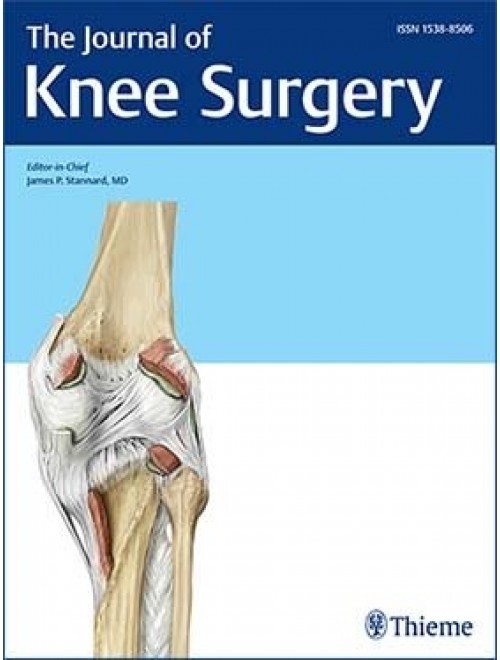
Suture vs arrow repair: No clear advantage of either technique for knee meniscus tears

Suture vs arrow repair: No clear advantage of either technique for knee meniscus tears
Suture Repair versus Arrow Repair for Symptomatic Meniscus Tears of the Knee: A Systematic Review
J Knee Surg. 2012 Nov;25(5):397-402. doi: 10.1055/s-0032-1313752. Epub 2012 May 15Did you know you're eligible to earn 0.5 CME credits for reading this report? Click Here
OE EXCLUSIVE
Synopsis
This systematic review included 4 studies (2 randomized controlled trials and 2 comparative observational studies) that compared arrow repair and suture repair for patients with symptomatic meniscus tears of the knee. Results indicated that there was no difference between the two repair techniques for the mean retear and healing rate, knee rating scores, and time to re-operation. However, the quality of evidence included in this review was not optimal and firm conclusions regarding the effectiveness of arrow repair compared to suture repair can not be made.
Were the search methods used to find evidence (original research) on the primary question or questions stated?
Was the search for evidence reasonably comprehensive?
Were the criteria used for deciding which studies to include in the overview reported?
Was the bias in the selection of studies avoided?
Were the criteria used for assessing the validity of the included studies reported?
Was the validity of all of the studies referred to in the text assessed with use of appropriate criteria (either in selecting the studies for inclusion or in analyzing the studies that were cited)?
Were the methods used to combine the findings of the relevant studies (to reach a conclusion) reported?
Were the findings of the relevant studies combined appropriately relative to the primary question that the overview addresses?
Were the conclusions made by the author or authors supported by the data and or analysis reported in the overview?
How would you rate the scientific quality of this evidence?
Yes = 1
Uncertain = 0.5
Not Relevant = 0
No = 0
The Reporting Criteria Assessment evaluates the transparency with which authors report the methodological and trial characteristics of the trial within the publication. The assessment is divided into five categories which are presented below.
4/4
Introduction
3/4
Accessing Data
3/4
Analysing Data
1/4
Results
2/4
Discussion
Detsky AS, Naylor CD, O'Rourke K, McGeer AJ, L'Abbé KA. J Clin Epidemiol. 1992;45:255-65
The Fragility Index is a tool that aids in the interpretation of significant findings, providing a measure of strength for a result. The Fragility Index represents the number of consecutive events that need to be added to a dichotomous outcome to make the finding no longer significant. A small number represents a weaker finding and a large number represents a stronger finding.
Why was this study needed now?
If possible, it is crucial for a patient with a tear in the meniscus to receive repair, as removal of the meniscus is associated with the onset of detrimental changes, such as knee osteoarthritis. Suture repair, a technique in which the edges of the torn meniscus are sutured, has been considered the gold standard repair method for meniscus tears for some time. However, some surgeons now employ the newer arrow repair technique instead of suture repair, and it is currently uncertain as to which technique is most effective with regards to clinical outcomes. This systematic review, therefore, aimed to gather data from various trials in order to determine which meniscal repair technique is superior in patients with meniscus tears.
What was the principal research question?
Is arrow repair more effective than suture repair with regards to the rate of retear and healing in patients with meniscus tears of the knee?
What were the important findings?
- 1 randomized controlled trial (RCT) indicated that there was no difference between the two techniques for the rate of failure (p=0.92)
- According to another RCT, the two techniques did not differ with respect to the healing rate (p=0.11); at repeat arthroscopy, full or partial healing of the menisci was seen in 30 patients in the arrow group and 24 patients in the suture group
- Based on the Hospital for Special Surgery Knee Rating System used in one observational study, satisfactory results (excellent or good results) were found in 17 patients of the suture group and 22 patients of the arrow group (the study indicated that there was no clinical difference between the two groups)
- According to the second observational study, there was no difference between the two groups for the mean time to re-operation (p=0.85)
What should I remember most?
There was no difference between the arrow and suture repair techniques with respect to healing and re-tear rates, knee rating scores, and mean time to re-operation.
How will this affect the care of my patients?
Firm conclusions regarding the optimal treatment for patients with meniscus tears of the knee can not be made due to the low quality of the studies used in this review. Further research with fewer methodological flaws and larger sample sizes are needed to compare arrow and suture repair in order to form definitive conclusions.
Learn about our AI Driven
High Impact Search Feature
Our AI driven High Impact metric calculates the impact an article will have by considering both the publishing journal and the content of the article itself. Built using the latest advances in natural language processing, OE High Impact predicts an article’s future number of citations better than impact factor alone.
Continue



 LOGIN
LOGIN

Join the Conversation
Please Login or Join to leave comments.